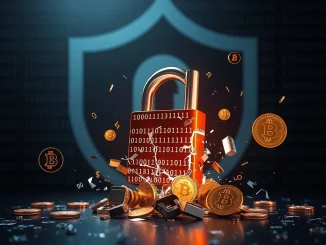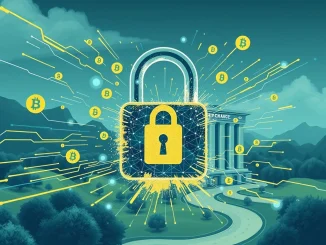
Are you an EOS network user? You need to pay close attention! A new threat is looming over the EOS blockchain, and it’s called address poisoning. Leading blockchain security firm, SlowMist, has raised a red flag, alerting the crypto community to a wave of these insidious attacks targeting EOS users. This isn’t just another technical jargon alert; it’s a real and present danger that could impact your digital assets. Let’s dive deep into what this means for you and how you can shield yourself from falling victim to this cunning scam.
What Exactly is Address Poisoning and Why Should EOS Users Be Worried?
Imagine this: you’re expecting a legitimate transaction in your crypto wallet. You check your transaction history to copy your address for a friend who wants to send you some EOS. But wait, something’s off. Amongst your genuine transactions, you spot a tiny, almost insignificant transaction – just 0.001 EOS – from an address that looks strikingly similar to your own. This, my friends, is likely an address poisoning attack in action.
Address poisoning is a deceptive tactic where scammers send minuscule amounts of cryptocurrency to numerous addresses from a source address crafted to resemble the recipient’s address. The goal? To sneakily insert their malicious address into your transaction history. When you’re in a hurry or not paying close attention, you might mistakenly copy the scammer’s address instead of your own legitimate address from your history for your next transaction. This simple mistake can lead to you unknowingly sending your funds directly into the scammer’s wallet. It’s a classic case of digital deception playing on human error.
Why is the EOS Network a Target Right Now?
While address poisoning attacks can technically target any blockchain, the recent alert from SlowMist specifically highlights the EOS network. The reasons behind targeting EOS specifically aren’t explicitly stated in the initial warning, but we can speculate on a few possibilities:
- User Activity: Perhaps there’s increased user activity or transaction volume on the EOS network, making it a more lucrative hunting ground for scammers. More transactions mean more opportunities for addresses to get poisoned and users to make mistakes.
- Vulnerability Perception: Scammers might perceive a weakness or a less vigilant user base within the EOS ecosystem. This could be entirely unfounded, but attacker strategies often involve targeting perceived points of least resistance.
- Specific Exploit: There might be a specific, albeit subtle, characteristic of the EOS network or its wallet infrastructure that makes it slightly more susceptible or attractive for this type of attack right now.
Regardless of the exact reason, the crucial takeaway is that EOS users are currently in the crosshairs and need to be extra vigilant.
SlowMist’s Warning: A Beacon in the Crypto Security Landscape
When a reputable firm like SlowMist issues a warning, the crypto community takes notice. Known for their proactive approach to crypto security and threat intelligence, SlowMist’s alert about blockchain attacks on the EOS network is a critical heads-up. Their expertise in identifying and analyzing blockchain vulnerabilities makes their warnings particularly credible and actionable.
SlowMist’s concise announcement on X served as an initial alarm bell, prompting EOS users and the wider crypto community to become aware of this ongoing threat. It underscores the importance of following reputable security firms and heeding their advice to stay safe in the often-turbulent waters of cryptocurrency.
Decoding the Attack: How Address Poisoning Works Step-by-Step
Let’s break down the mechanics of an address poisoning attack to understand how these scammers operate and how to avoid their traps:
- Address Similarity Crafting: Scammers generate numerous cryptocurrency addresses that are intentionally very similar to common address formats and, crucially, to real user addresses they are targeting. They might change a character or two, making it visually easy to mistake for a legitimate address, especially under hurried circumstances.
- Low-Value Transaction Blitz: Using these crafted addresses, they initiate a flood of tiny transactions (like the 0.001 EOS mentioned) to a vast number of potential victim addresses. The cost to the attacker is minimal, but the potential payoff is significant if even a small percentage of users fall for the scam.
- Transaction History Contamination: These transactions, though insignificant in value, get recorded in the transaction history of the recipients’ wallets. Over time, as users conduct more transactions, these poisoned addresses get buried within the history, waiting for the opportune moment.
- Exploiting User Behavior: The scam preys on the common user behavior of copying addresses from their own transaction history for convenience and speed. In a rush to send funds, users might glance at their history, see an address that looks familiar, and mistakenly select the poisoned address.
- Fund Diversion: Unsuspecting users, thinking they are copying their own address or a previously used trusted address, inadvertently copy the scammer’s address. When they initiate a real, valuable transaction, their funds are sent directly to the scammer’s wallet instead of the intended recipient.
Protecting Your EOS Assets: Actionable Steps Against Address Poisoning
The good news is that address poisoning attacks are preventable. By adopting a few careful habits, you can significantly reduce your risk. Here’s your🛡️ crypto security toolkit to combat these blockchain attacks:
- Double-Check, Triple-Check Addresses: This is the golden rule. Always meticulously verify the entire recipient address before sending any cryptocurrency. Don’t just rely on visual similarity. Compare every character, especially the beginning and end.
- Avoid Copying from Transaction History (When Possible): While convenient, relying solely on transaction history can be risky. Whenever possible, obtain the recipient’s address directly from a trusted source each time, such as their official website, a secure messaging app, or by scanning a QR code.
- Use Address Book/Whitelisting Features: Most reputable cryptocurrency wallets allow you to save frequently used addresses in an address book or create a whitelist of trusted addresses. Utilize these features to manage and verify your recipient addresses proactively.
- Be Wary of Tiny, Unsolicited Transactions: If you notice small, unexpected transactions from unfamiliar addresses in your wallet, especially if the sender address looks suspiciously like yours, treat it as a potential red flag. Don’t interact with these transactions beyond noting their presence.
- Utilize Wallet Security Features: Explore and enable all security features offered by your EOS wallet, such as transaction confirmation prompts, address verification tools, and alerts for unusual activity.
- Stay Informed and Educated: Keep yourself updated on the latest crypto security threats and best practices. Follow reputable security firms like SlowMist and crypto news outlets to stay ahead of potential dangers.
Is Address Poisoning a New Threat?
While the current wave targeting the EOS network is a timely reminder, address poisoning itself isn’t a brand-new type of blockchain attack. It’s a technique that has been observed across various blockchains for some time. However, the effectiveness of this attack vector lies in its simplicity and reliance on human error, making it perennially relevant and concerning.
The fact that SlowMist has issued a specific warning for the EOS network suggests either an uptick in these attacks on EOS or a newly identified campaign specifically targeting EOS users. This highlights the ever-evolving nature of crypto scams and the constant need for vigilance.
Staying Safe in the EOS Ecosystem and Beyond
The address poisoning attack on the EOS network serves as a stark reminder of the ongoing security challenges in the cryptocurrency space. While the EOS network is currently under scrutiny, the lessons learned are universally applicable to all crypto users, regardless of the blockchain they use. Maintaining a proactive security mindset, practicing diligent address verification, and staying informed about emerging threats are your best defenses against these and future crypto security risks.
By understanding how these scams work and taking the necessary precautions, you can navigate the crypto world with greater confidence and safeguard your valuable digital assets. Stay alert, stay informed, and stay secure!



